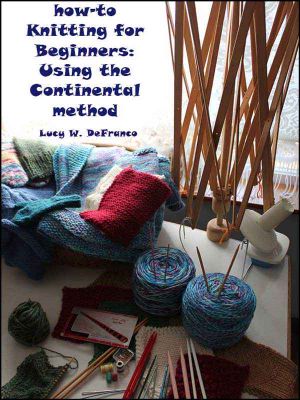How to Knitting for Beginners · Using the Continental Method

- Authors
- DeFranco, Lucy W. & Welsh, James & Defranco, Raphael
- Publisher
- Lucy W DeFranco
- Tags
- crafts; hobbies & home , crafts & hobbies , needlecrafts & textile crafts , knitting
- Date
- 2012-01-24T00:00:00+00:00
- Size
- 2.54 MB
- Lang
- en
Perhaps you are a beginning knitter and want to start by learning the most efficient and effective fundamentals. Or, you may have been knitting for a while, but you knit slowly and wish you could knit faster. Have you ever wondered if you could increase your speed AND your efficiency at the same time?
What if there were a book that could teach you, in just a few short weeks, the fundamentals you need to enjoy a lifetime of confidence and satisfaction in your knitting skills? What if that book also included knitting patterns for hats, scarves, baby blankets, and more? And what if that book had dozens and dozens of high quality photographs showing you exactly what your hand and finger positioning should be as you go through the steps of a technique?
Many knitters in the US and the UK have learned to 'throw' their yarn onto their needles with a lot more effort than they need to, resulting in a consistently slower rate of knitting and an inefficient use of the fingers and hands. Strangely enough, this is a holdover from World War II, when the Continental knitting method fell out of favor among Allied populations due to its association with Germany. The Continental method is the most efficient and quickest way to knit, yet many English language knitting books still teach the English or American styles.
A woman named Elizabeth Zimmermann famously used her books and a PBS series to reintroduce the Continental method and 'knitting in the round' to several generations of American knitters from the 1950's until her death in 1999. Although EZ, as she was affectionately referred to by many knitters, had a major influence on the contemporary knitting scene, a glance through many recent books and instructional videos still reveals a widespread lack of knowledge about the most efficient away to manipulate the yarn and needles with your hands and fingers.
This book was written to address that gap in knowledge and is divided into six weekly lessons which start with basic fundamentals, and end with intermediate level skills and projects. In this book you will find: how-to knitting for beginners, knitting patterns for hats, knitting patterns for scarves, knitting patterns for baby blankets, a wealth of high quality photos showing you how to perform the techniques properly, and a rich listing of additional resources the blossoming knitter can go to for further development and inspiration.
Lucy W. DeFranco taught beginning knitting lessons for a number of years, and elaborated and expanded upon the lesson plans for those classes to create this book. Although her particular techniques are not quite identical to Zimmermann's, like her grandmother before her she is capable of producing prodigious amounts of knitted material when she wants to, and she credits this to the efficiency of the Continental method. Ms. DeFranco is also an accomplished weaver, fiber artist, and language teacher, and has raised many different kinds of wool-bearing animals. She was also one of the co-founders of The Web*sters, a knitter's and weaver's supply store in Ashland, Oregon.